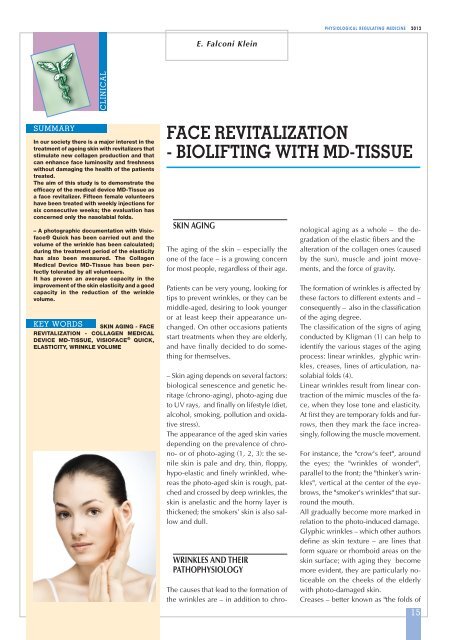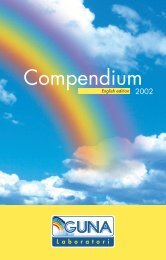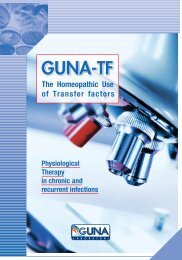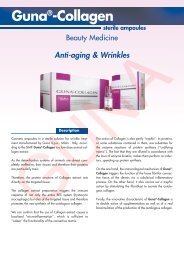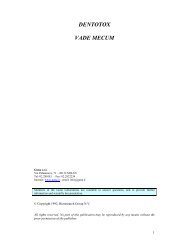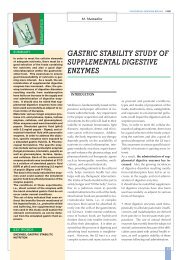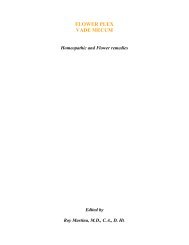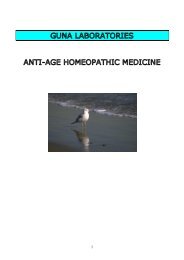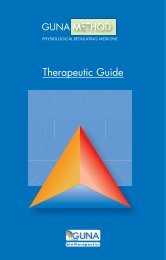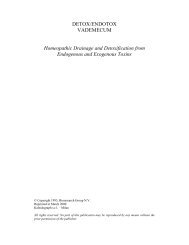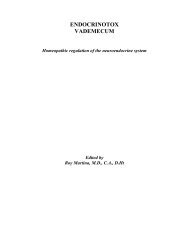Face Revitalization - Biolifting with MD-Tissue - Cyto-Solutions Ltd
Face Revitalization - Biolifting with MD-Tissue - Cyto-Solutions Ltd
Face Revitalization - Biolifting with MD-Tissue - Cyto-Solutions Ltd
You also want an ePaper? Increase the reach of your titles
YUMPU automatically turns print PDFs into web optimized ePapers that Google loves.
P H Y S I O L O G I C A L R E G U L AT I N G M E D I C I N E 2 0 1 2E. Falconi KleinCLINICALSUMMARYIn our society there is a major interest in thetreatment of ageing skin <strong>with</strong> revitalizers thatstimulate new collagen production and thatcan enhance face luminosity and freshness<strong>with</strong>out damaging the health of the patientstreated.The aim of this study is to demonstrate theefficacy of the medical device <strong>MD</strong>-<strong>Tissue</strong> asa face revitalizer. Fifteen female volunteershave been treated <strong>with</strong> weekly injections forsix consecutive weeks; the evaluation hasconcerned only the nasolabial folds.– A photographic documentation <strong>with</strong> Visioface®Quick has been carried out and thevolume of the wrinkle has been calculated;during the treatment period of the elasticityhas also been measured. The CollagenMedical Device <strong>MD</strong>-<strong>Tissue</strong> has been perfectlytolerated by all volunteers.It has proven an average capacity in theimprovement of the skin elasticity and a goodcapacity in the reduction of the wrinklevolume.KEY WORDSSKIN AGING - FACEREVITALIZATION - COLLAGEN MEDICALDEVICE <strong>MD</strong>-TISSUE, VISIOFACE ® QUICK,ELASTICITY, WRINKLE VOLUMEFACE REVITALIZATION- BIOLIFTING WITH <strong>MD</strong>-TISSUESKIN AGINGThe aging of the skin – especially theone of the face – is a growing concernfor most people, regardless of their age.Patients can be very young, looking fortips to prevent wrinkles, or they can bemiddle-aged, desiring to look youngeror at least keep their appearance unchanged.On other occasions patientsstart treatments when they are elderly,and have finally decided to do somethingfor themselves.– Skin aging depends on several factors:biological senescence and genetic heritage(chrono-aging), photo-aging dueto UV rays, and finally on lifestyle (diet,alcohol, smoking, pollution and oxidativestress).The appearance of the aged skin variesdepending on the prevalence of chrono-or of photo-aging (1, 2, 3): the senileskin is pale and dry, thin, floppy,hypo-elastic and finely wrinkled, whereasthe photo-aged skin is rough, patchedand crossed by deep wrinkles, theskin is anelastic and the horny layer isthickened; the smokers’ skin is also sallowand dull.WRINKLES AND THEIRPATHOPHYSIOLOGYThe causes that lead to the formation ofthe wrinkles are – in addition to chronologicalaging as a whole – the degradationof the elastic fibers and thealteration of the collagen ones (causedby the sun), muscle and joint movements,and the force of gravity.The formation of wrinkles is affected bythese factors to different extents and –consequently – also in the classificationof the aging degree.The classification of the signs of agingconducted by Kligman (1) can help toidentify the various stages of the agingprocess: linear wrinkles, glyphic wrinkles,creases, lines of articulation, nasolabialfolds (4).Linear wrinkles result from linear contractionof the mimic muscles of the face,when they lose tone and elasticity.At first they are temporary folds and furrows,then they mark the face increasingly,following the muscle movement.For instance, the "crow's feet", aroundthe eyes; the "wrinkles of wonder",parallel to the front; the "thinker’s wrinkles",vertical at the center of the eyebrows,the "smoker's wrinkles" that surroundthe mouth.All gradually become more marked inrelation to the photo-induced damage.Glyphic wrinkles – which other authorsdefine as skin texture – are lines thatform square or rhomboid areas on theskin surface; <strong>with</strong> aging they becomemore evident, they are particularly noticeableon the cheeks of the elderly<strong>with</strong> photo-damaged skin.Creases – better known as "the folds of15
P H Y S I O L O G I C A L R E G U L AT I N G M E D I C I N E 2 0 1 2sable gloves, iodine based solution, alcoholicsolution, sterile gauzes, ethylchloride spray.- Sterile needles (27G)- Syringes (5 or 10 cc), depending onthe amount of solution to be injected.– Contraindications / Side EffectsNo case of hypersensitivity to <strong>MD</strong>-<strong>Tissue</strong>has been reported.Patients <strong>with</strong> known hypersensitivity tothe component or the excipients mustbe previously undergo injecting test inthe arm and kept under observation forone hour.– Protocol applied for revitalization<strong>with</strong> <strong>MD</strong>-<strong>Tissue</strong>Before proceeding <strong>with</strong> the treatment allthe volunteers signed an informed consent.Then an allergological test <strong>with</strong> intracutaneousinjection of a smallamount of <strong>MD</strong>-<strong>Tissue</strong> was performed onall the volunteers in order to exclude apossible sensitization.None of the 15 volunteers had any adversereaction to <strong>MD</strong>-<strong>Tissue</strong>.– After a phase of clinical observationlasting 30 minutes – which is generallysufficient to exclude immediate type Iallergic reactions – basal measurementshave been taken (time 0, T0) by performinga measurement of the skin elasticityof the nasogenian fold and a photographof the face performed <strong>with</strong> theVisioscan ® was also taken.It was decided to apply a pattern that isfrequently chosen in various protocolsfor anti-aging revitalization of the face.The injective treatment <strong>with</strong> <strong>MD</strong>-<strong>Tissue</strong>was performed once a week for 6 consecutiveweeks.At each session it was injected intradermallya 2ml vial of <strong>MD</strong>-<strong>Tissue</strong> in the nasogenianfolds, following linearly thenasogenian fold <strong>with</strong> the tunnelingtechnique.Some volunteers have called for the applicationof an anesthetic cream priorto receiving this treatment.The needle used was 27G.After the 3rd session and prior to the 4thsession, intermediate measurements (time3 weeks, T3) were taken <strong>with</strong> photo-documentationand measurement ofthe elasticity, so to be able to better assessthe progress of the treatment.At the end of the treatment (after the 6thsession) – 7 days after the last treatment– the latest measurements were carriedout, always <strong>with</strong> photo-documentationand measurement of the elasticity.– Self-evaluation formAt the end of the treatment, the volunteersfilled out a self-evaluation form.The votes are comprised between 0 and10, where 0 is equivalent to "not at all"and 10 to "very much." The evaluationis expressed spontaneously, in writingand kept reserved by the patient toavoid any influence from the doctor.The questions that have been chosen forthis experiment are the following:TAB. 1Long term skin elasticity.1. To what extent do you think thatthe product reduces the visibilityof the expression lines?2. To what extent do you think thatthe product reduces the visibilityof micro wrinkles?3. To what extent do you think thatyour wrinkles are less deep?4. To what extent do you think thatthe product increases skin elasticity?5. To what extent do you think thatthe product increases your skinbrightness?6. To what extent do you think thatyour skin looks fresher / revitalized?7. To what extent do you think thatthat the product increases yourskin firmness?8. To what extent do you think thatthe product increases your skinsmoothness?9. To what extent do you think that theproduct improves your skin texture?Long term skin elasticityVolunteern. t0 t 3 weeks t 6 weeks1 0,8123 0,8129 0,70922 0,6720 0,6786 0,72133 0,8785 0,8591 0,80884 0,6879 0,7143 0,73985 0,6906 0,7990 0,69316 0,7642 0,8412 0,85267 0,7500 0,8452 0,84008 0,7654 0,8168 0,80009 0,8265 0,8022 0,838710 0,8406 0,8300 0,837711 0,7721 0,8128 0,663312 0,7893 0,8084 0,828013 0,8150 0,7738 0,660614 0,7686 0,8254 0,681215 0,8030 0,8138 0,8067Average 0,776 0,802 0,765Dev. STD 0,0584572575 0,0480712665 0,0716924682∆% 3,4 -1,317
P H Y S I O L O G I C A L R E G U L AT I N G M E D I C I N E 2 0 1 210. To what extent do you think thatyour skin looks healthier?11. To what extent do you think thatthe product gives your skin a"comfortable" feeling?In the interpretation of the results it wasdecided to unify some votes to avoid dataloss.– The votes 9 and 10 are considered"very good"; 7 and 8 "good"; 6 "fair"; 3,4 and 5 "poor".– Skin elasticitymis and that the recovery distensibilitybriefs about the conditions of the elasticfibers (4).– Photographic documentationThe photographic documentation wasperformed <strong>with</strong> the computer system Visioface® Quick (full face photo analysis),CK electronic GmbH Koeln (Germany).RESULTS– Results of the measurement of skinelasticityThe results of the measurements of skinelasticity carried out on 15 volunteersat T0 (before treatment <strong>with</strong> revitalizing<strong>MD</strong>-<strong>Tissue</strong>) at T3 (1 week after the 3rdtreatment, i.e before the 4th) and at T6(1 week after the 6th and final treatment)are presented.– The measurement was always performedon the nasogenian folds.TAB. 1 lists all the numerical results of the15 volunteers <strong>with</strong> their values at T0, T3and T6.– Overall, there was a slight increase inskin elasticity after 3 weeks of treatment,and after 6 weeks, the values return almostto baseline. The average of the va-Skin elasticity is defined as the ability ofthe skin to stretch <strong>with</strong>out breaking down,then returning to its original shape.It has been measured <strong>with</strong> the elastomer(Cutometer ® MPA 580, Courage-KhazakaElectronic GmbH, Koeln, Germany).Applied to the skin, this device performsa suction of a part of the skin and theheight reached by the aspirated layer refersto its degree of tensile distensibility;repeating several times the same maneuver,a further increase of skin distensibilitycan be observed – defined astensile stretching, which is evaluatedand recorded by the device.The latest and most refined dermatological-physiologicalresearch could findthat distensibility reflects the state ofhealth of the collagen fibers of the derlueswhich initially was 0.776 increaseson average to 0.802 after 3 weeksand then lowers again to 0.765.After 3 weeks of treatment, 11 out of 15volunteers (73.33%) show greater elasticitycompared to the beginning.Only 4 volunteers (number 3, 9, 10, 13)(26.33%) show a lowering of elasticityafter the first three treatments.After 6 weeks of treatment 9 voluntaryout of 15 (60%) have greater elasticitythan at the beginning, while 6 volunteers(number 1, 3, 10, 11, 13, 14)(40%) have a lowering of the elasticityunder values of T0.TAB. 2 represents graphically the resultsrecorded by the volunteers (1-15).– Results of photographic documentationVisioface ® QuickThe volume and depth of wrinkles werestudied <strong>with</strong> Visioface ® Quick and the dataprocessing was performed <strong>with</strong> theprogram Skin Surface Analyzer SSA.From the front picture of the complete faceit is chosen a small area located on theright or left nasogenian fold of each patient,this selected rectangular area correspondsto the "surface" of the wrinkle.The "depth" of the wrinkle is measuredin AU (Adimensional Unit).It is a measurement scale created on acolorimetric basis to give depth to theselected area.0,85000,80000,75000,70000,6500t0 t 3 weeks t 6 weeks123456789101112131415TAB. 2Skin elasticity,graphicalrepresentation foreach patient.18
L A M E D I C I N A B I O L O G I C A O T T O B R E - D I C E M B R E 2 0 1 2Wrinkle volume mm 2 X A.U.Volunteern. t0 t 3 weeks t 6 weeks %1 0,4500 0,4500 0,3200 -28,92 0,2400 0,2000 0,2200 -8,33 0,1000 0,0900 0,0900 -10,04 0,1300 0,1600 0,1000 -23,15 0,8100 0,8500 0,7200 -11,16 0,2800 0,2300 0,2400 -14,37 0,2300 0,2300 0,1900 -17,48 0,2100 0,2500 0,2000 -4,89 0,1700 0,1900 0,1700 0,010 0,0800 0,0900 0,0800 0,011 0,3800 0,3600 0,3200 -15,812 0,1100 0,1000 0,1000 -9,113 0,5300 0,4000 0,4800 -9,414 0,2200 0,2400 0,2000 -9,115 0,1600 0,1500 0,1200 -25,0Average 0,273 0,266 0,237Dev. STD 0,19722 0,19449 0,17182∆% -2,7 -13,4TAB. 3Wrinkle volumemm 2 2 X A.U. <strong>with</strong>decreasepercentage of eachpatient after 6-weektreatment.The "volume" of the wrinkle is the resultof the following calculation:Volume of the wrinkle (mm (2)) = AU xheight (mm) x width (mm) x depth.The volume of wrinkles was reducedby a total of 2.7% after 3 weeks and13.4% after 6 weeks of treatment.The values ranged from 0% to 28.9%.– Results of self-assessmentHere below are shown the 11 questionsalong <strong>with</strong> the opinions expressed invotes and in percentage to which the 15patients of the trial replied:1. To what extent do you think that theproduct reduces the visibility of theexpression lines?– The ability to reduce the visibilityof the expression lines is consideredby 80% of patients "good", by6.67% "fair" and by 13.33% “poor”.2. To what extent do you think that theproduct reduces the visibility of microwrinkles?– The ability to reduce the visibilityof micro wrinkles is considered by13.33% of patients "very good", by53.33% "good", by 20% "fair" andby 13.33% "poor".3. To what extent do you think thatyour wrinkles are less deep?– The perception of less deep wrinklesis for 6.67% of patients "verygood", for 80% "good" and for13.33% "poor".4. To what extent do you think that theproduct increases the skin elasticity?– The increase in the skin elasticityis perceived by 86.67% of patientsto be "good" and by 13.33% "fair".5. To what extent do you feel that theproduct increases the brightness ofyour skin?– The increase in brightness is held“very good” by 13.33% of the patients,“good” by 66.67%, “fair” by6.67% "fair" and “poor” by 13.33%.6. To what extent do you think thatyour skin looks fresher / revitalized?– The perception of a fresh and revitalizedskin is for 13.33% of patients"very good", for 66.67%"good" and for 20% "fair”.7. To what extent do you think thatthe product increases your skinfirmness?– The increase in firmness is consideredby 6.67% of patients "verygood", by 73.33% "good" and by20% "fair".8. To what extent do you think thatthe product increases your skinsmoothness?– The increase in smoothness isperceived by 6.67% of patients as"very good", by 60% "good" andby 33.33% "fair".9. To what extent do you think thatthe product improves your skintexture?– The improvement in the skin textureis considered by 6.67% of patients"very good", by 46.67%"good" and by 46.67% "fair".10. To what extent do you think thatyour skin looks healthier?– The perception of a healthier skinis for 6.67% of patients "verygood", for 80% "good" and for13.33% "fair”.11. To what extent do you think thatthe product gives your skin a19
L A M E D I C I N A B I O L O G I C A O T T O B R E - D I C E M B R E 2 0 1 2"comfortable" feeling?– The perception of a sense of"comfort" is for 6.67% of patients"very good", for 73.33% "good",for 13.33% "fair" and for 6.67%"poor".DISCUSSIONThe aim of this study was to demonstratethe effectiveness of the medical device<strong>MD</strong>-<strong>Tissue</strong> as facial revitalizer.15 patients – 33-50 years – were evaluated;first they underwent an allergytest <strong>with</strong> the provocation of a small intracutaneouswheal to exclude sensitizationto the product.<strong>MD</strong>-<strong>Tissue</strong> showed an acceptability of100%, none of the patients experienceddiscomfort or side effects.Consequently, they were administeredweekly injections of <strong>MD</strong>-<strong>Tissue</strong> (2.0ml), exclusively in the nasogenianfolds. At the beginning of the treatment(T0), after 3 weeks (T3) and after 6weeks (T6) a photographic documentationwas performed using Visioface ®Quick and the measurement of elasticityusing the elastomer (Cutometer Courage- Khazaka).At the end of the treatment the patientscompleted a self-evaluation questionnaire.After 3 weeks of treatment the elasticityvalues showed an improvement of73.33% and have achieved a total improvementof 3.4%; after 6 weeks oftreatment they stabilized at 60%.In order to achieve more indicative values,further measurements and – aboveall – a higher number of patients maybe required.results were highly positive.The overall improvement of the patients,<strong>with</strong> a lowering of the wrinkle volumecalculated by the Skin Surface Analyzer,was of -2.7% after 3 weeks and -13.4%after 6 weeks <strong>with</strong> peak improvementsin the depth of wrinkles even reaching28.9%.– This very satisfactory result is also reflectedin the data interpretation foundin the patients’ self-assessment questionnaireand in their happiness:80% considered "good" the reductionof the visibility of the expression lines;they considered that the wrinkles on theface are less deep, and their skin healthier.86, 67% considered "good" the increasein elasticity; 73.33% judged as"good"; 6.67% as "very good" the increasein the skin compactness; they alsothought that the product gives a feelingof comfort.66.67% considered "good" and13.33% "very good" the increase in skinbrightness; they also thought the skinlooked fresher and more revitalized.In conclusion we can confirm that themedical device <strong>MD</strong>-<strong>Tissue</strong> revealed to bea reliable and safe product for the face revitalization.– This can lead to several different usesin aesthetic medicine. The fluid texture ofthe product is definitely very suitable forthe treatment of the neck, décolletage andback of the hands.<strong>Face</strong> applications can include severaltechniques such as the treatment <strong>with</strong> microwheals, injections in acupuncturepoints, eye zone and forehead rejuvenation.References1. Kligman L. - Photoaging: manifestations, preventionand treatment. Clin Geriatr Med 1989;5: 235-251.2. Gilchrest B.A. - Skin aging and photoaging: anoverview. J Am Acad Dermatol 1989; 21: 510-513.3. Kang S., Fisher G.J., Voorhees J.J. - Photoaging:pathogenesis, prevention and treatment. Clin GeriatrMed 2001; 17: 643-659.4. Fracassi P., Marottoli M.S. - Dizionario di Dermocosmesi.Tecniche nuove, 2006.5. Milani L. - Un nuovo e raffinato trattamento iniettivodelle patologie algiche dell'apparato locomotore.La Med. Biol., 2010/3; 3-15.6. De Bellis M. - Omeomesoterapia in medicinaestetica, Scuola di Omeopatia-Omotossicologiae Discipline Integrate. Dispense AA. 2011-2012.AcknowledgementsThe author thanks the BIOBASIC EUROPE SRLstaff for their collaboration as well as for the use oftheir devices.However, the effect is present and elasticityin this work was higher after 3weeks than after 6 weeks of treatment.As for the photographic documentationobtained through the device Visioface®Quick and the data calculation achieved<strong>with</strong> the Skin Surface Analyzer SSA,AuthorDr. E. Falconi Klein, <strong>MD</strong>– Specialist in Dermatology– Specialist in AllergologyVia Mauro Macchi, 42I – 20124 - Milano20


